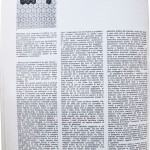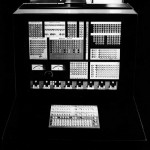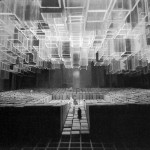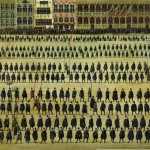Six drawings have been realized by French architect and artist François Dallegret when asked in 1965 by Magazine Art in America to illustrate the article by Reyner Banham “A Home is not a House” (Art in America #2, 1965).
In A Home is Not a House, Banham attacks the North-American houses, built without a proper protection from cold and warm weather, based upo a widespread use of heating pumps, a general waste of energy and the production of an “environmental machinery”.
It starts like this:
“When your house contains such a complex of piping, flues, ducts, wires, lights, inlets, outlets, ovens, sinks, refuse disposers, hi-fi reverberators, antennae, conduits, freezers, heaters – when it contains so many services that the hardware could stand up by itself without any assistance from the house, why have a house to hold it up?”
The drawing “Anatomy of a dwelling” shows a huge network of cables and tubes, an accumulating “baroque ensemble of domestic gadgets” between the sky (with a Tv antenna) and the earth (a septic unit).
Naked and sat around a technological totem, Banham and Dallegret appear in “Transportable standard-of-living package” a mobile habitat environmentally friendly, equipped by solar panels, for an hippy yet hypertechnological nomad youth.
Find a copy of the original article in pdf on Studio 4 Postindustrial.
Transcribed text here.
Read more: “Ecology without the Oikos: Banham, Dallegret and the Morphological Context of Environmental Architecture” on field-journal.org
The drawings are the following, and they now belong to the Frac collection:
Click to zoom:
Un-House. Transportable Standard-of-Living Package
A home is not a house
Anatomy of a dwelling
Power membrane
Super coupe de long Week End
Trailmaster GTO
And here an excerpt from the review by Charles Jencks:
“The two ideas behind this are to give everyone a standard of living package containing all the necessities of modern life (shelter, food, energy, television) and to do away with all the permanent structures of building, and men would not be constrained by past settlements.
the advantage of pushing present tendencies to such extremes is that the extremes indicate possibilities not otherwise exploited and present alternatives in a clear light. perhaps the furthest limit in increasing ephemerality is either religious mysticism, or a mood controlled environment which is induced entirely in the mind – through drugs, and electrodes implanted on the brain. in this situation, all artifacts would disappear entirely and the only thing left would be a contemplative trance having much the same advantage over tangible things that st. bernard pointed out over eight centuries ago.
it may be doubted whether the mood controlled environment was exactly what he was proffering, but there can be no doubt – what with the eight century trend toward a sensate culture and the present possibility of stimulating the pleasure centres of the brain – that certain groups will be tempted to construct it. what exactly it would look like is best left to the imagination.”
Charles Jencks, Architecture 2000, 1969






[…] Articulo “A Home is not a House“ […]